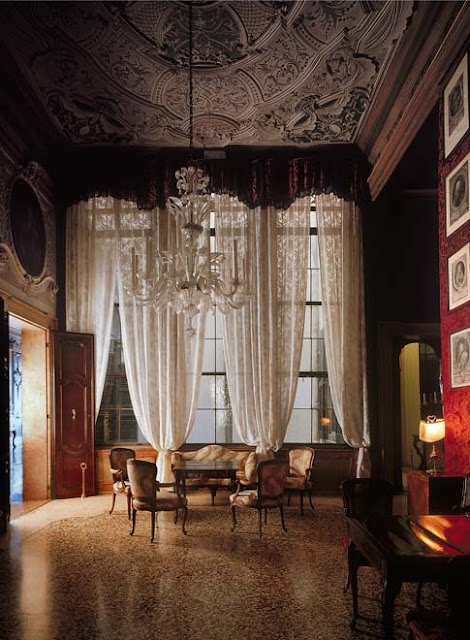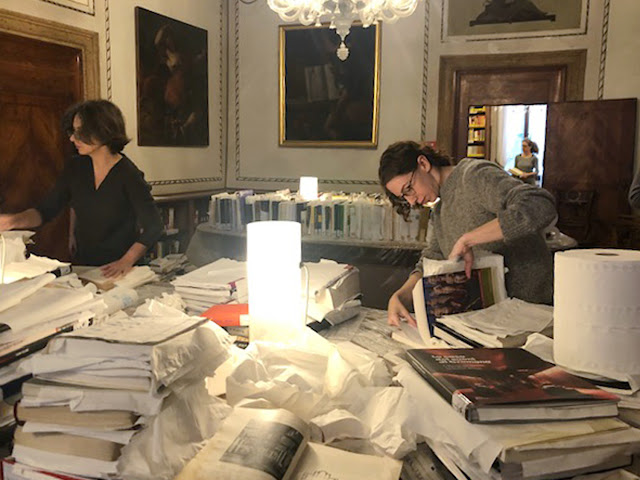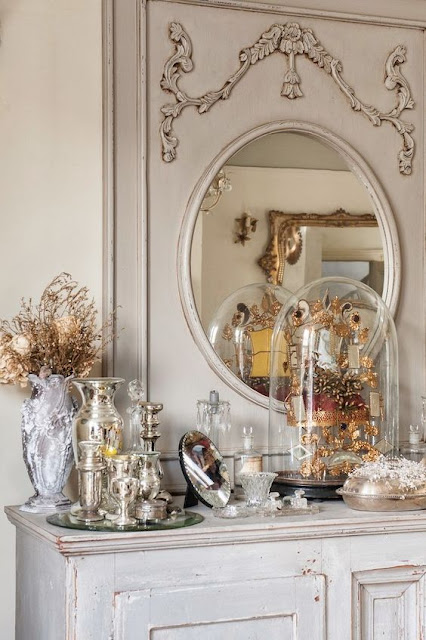There are some elements of design that are iconic symbols of refined taste and wealth. Murano glass chandeliers are one of those symbols and are recognizable all over the world. Since the 13th century the island of Murano has been the undisputed nerve center for Venetian glass production. With the creation of cristallo, a transparent glass that was considered the finest glass in the world, and a white colored glass (that we know as milk glass) called lattimo, Murano became Europe's first major glassmaking center, reaching the peak of its popularity in the 15th and 16th centuries. The first Murano glass chandeliers to be produced by Venetian glassmakers date back around the year 1700. You have to remember that these chandeliers replaced the heavy wooden and wrought iron chandeliers of the past. Can you imagine how these beautiful translucent chandeliers appeared airy and almost magical. Is it any wonder the Murano glass chandelier was desired for grand and opulent interiors?
Today the descendants of these famous glassmakers continue to create gorgeous chandeliers and other pieces of glass art that are coveted by modern-day customers.
Around 1730 the Rezzonico family ordered a chandelier from Murano masters for the grand residence they were building, Ca'Rezzonico, overlooking the Grand Canal in Venice.
Glass masters in the factory of Giuseppe Briati created what it's now called the Rezzonico Chandelier, a fabulous two-tier colorful work of art featuring twenty candle-holders. This chandelier is representative of the classic Murano chandelier. It is considered the most amazing such chandelier in existence today and still hangs in it's original room at Ca'Rezzonico.
via pinterest.ru
Murano Glass chandeliers are still produced in Murano workshops and are in high demand for residences, hotels, theaters, restaurants, and other public spaces. Here they hang in Venice's Palazzo Widmann built in 1630. These chandeliers are decorated with gorgeous colors and are meant to represent a bouquet of flowers.
The Murano glass industry flourished as the artists pushed themselves to create unique and elaborate chandeliers for the rich Venetian nobility.
The beautiful Murano glass chandeliers were such a success they instantly brought chandeliers to a new dimension.
Elaborate yet delicate arabesques of beautifully colored leaves, flowers, and fruits are typical features of Murano glass chandeliers.
This was made possible by the unique type of glass used in Murano. It was called soda glass and was famous for it's extraordinary lightness which was different from all other glass at the time.
With their colors and fantastical artistry, Murano glass chandeliers add a bit of whimsy to the seriousness of otherwise grand interiors.
Designer, Jacques Garcia
Although Venetian glassmaking in factories existed as far back as the 8th Century, it did not originate on the island of Murano. Beginning in 1291 the Venetian Republic ordered the glassmakers to move their furnaces to the island because the glass factories caught fire frequently and posed a threat to the city.
Plus the Venetian glassmaker's secret formulas and methods of producing these fabulous chandeliers would be better protected and controlled on the island of Murano.
via Pinterest
This old world formal dining room by Renzo Mongiardino features a stunning 17th-century Murano glass chandelier.
Another extremely beautiful and delicate Murano glass chandelier in Christian Dior’s Château de la Colle Noire.
A Murano glass chandelier graces the dining room at Dumfries House, considered the most beautifully intact house in Scotland.
A close view of the Dumfries House glass chandelier.
Equally beautiful are the clear Murano glass chandeliers. A series of these beautiful chandeliers beckon you down this fabulous corridor. In the 15th century master glassmaker Angelo Barovier discovered the processes of making “Cristallo Veneziano”, the world's first truly clear glass
Rosenborg Palace in Copenhagen
One of the first Murano chandeliers was made for Frederick IV of Denmark and still hangs in his former palace, Rosenborg.
via Pinterest
Decoration was always put before functionality when it came to Murano glass chandeliers. These status symbols were means of showing one's wealth firstly, illumination came in second.
via Pinterest
In other countries crystal was being used on chandeliers. Since Murano glass was extremely fragile it could not be faceted so the Venetian glassmakers relied on the delicate and unique quality of their glass.
I love the way the clear glass Murano chandeliers seem to float in the room.
Exquisite Murano glass chandelier at Ca' Sagredo Hotel in Venice.
Venice's importance as a center of commerce and it's grip on trade routes began to vanish in the 17th century. As a result Murano glass entered a period of decline as England, France, and Czechoslovakia emerged as new craft centers thus ending Murano's monopoly on glassmaking.
More hardship was felt by the Murano glass manufacturers with the occupation of Napoleon Boneparte in 1797. Many glass furnaces were closed and the production of Murano glass pretty much came to a halt.
By 1820, only sixteen glass furnaces remained in the area. Only two prominent glass making families were left: the Salviati family and the Fratelli Toso, a group of six brothers known for their creative and imaginative artistry.Today their descendants continue the family trade.
via Pinterest
The Murano glass industry saw revival when Salviati exhibited over 500 works made by his firm at the Universal Exposition in Paris in 1867. By 1869 the industry was booming once again.
via Pinterest
Magnificent Murano glass chandelier in the Nymphenburg Palace, Munich.
The dining room is a perfect spot for a Murano glass chandelier as evidenced here in this one by designer Axel Vervoordt.
Magnificent Murano glass chandelier in the Bauer Il Palazzo - Venice, Italy. Is this not a gorgeous interior!!
Interior by Mario Buatta featuring a large Murano glass chandelier.
Murano glassmakers continue to carry on the traditions of craftsmanship and quality that made their chandeliers world famous since the ancient times. This one is from the 20th century.
Design Firm Studio Peregalli via architecturaldigest.com
Tips for determining if a Murano glass chandelier is the "real thing": Murano glass is hand-blown, meaning there should be bubbles and asymmetrical qualities. Look for misshapen flowers, glass that's a little cloudy or colors that have bled a bit. Also you should see the pontil mark where the glass blower broke the pontil rod from the finished piece. If it is perfect, it is NOT authentic.
Even in a modern day space a Murano glass chandelier will evoke magnificent Venetian interiors of the 17th century.
A Murano glass chandelier will add glamour to any style interior. You can count on them to provide a beautiful focal point for you room.
Designer Carlton Varney via theglampad.com
Murano glass chandeliers are quite expensive. Think of them as an investment that will definitely bring oohs and aahs from your guests.
Designer Diane Burn
Today Murano glass chandeliers are widely appreciated as one of the world's most beautiful and decorative types of chandelier.
As I worked on this blog post the city of Venice was struck by devastating flooding and is still reeling from a week of three exceptional tides whose floodwaters have caused massive damage to the city's cultural legacy and to residences and businesses.
The Querini Stampalia Foundation is located in an 18th century Venetian palazzo. An elegant room with Murano glass chandeliers is now a rescue center for precious books from the foundation's seriously damaged library.
Our prayers are with the people of Venice.
Click here to see the previous post
This blog post was published by Lisa Farmer













































































